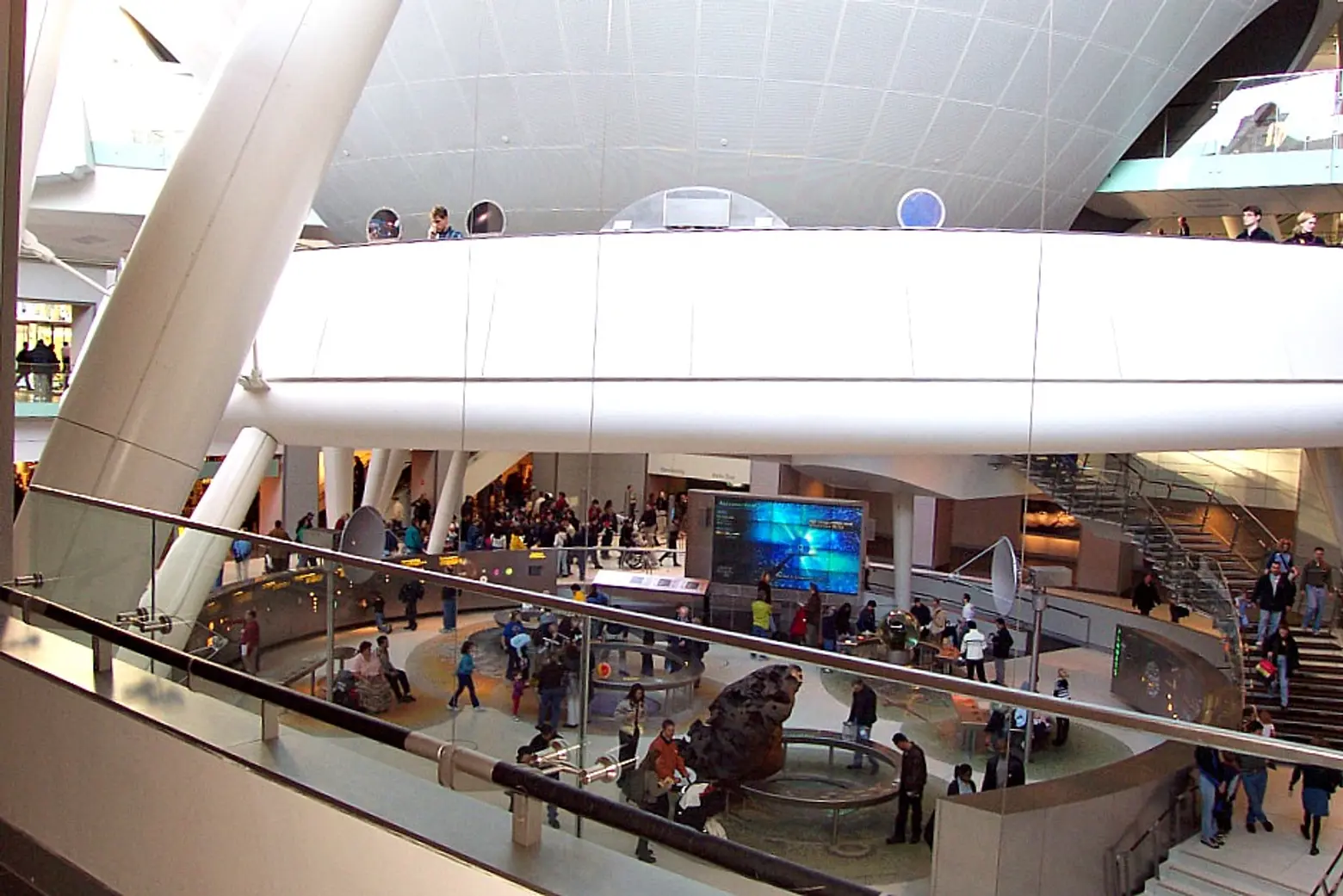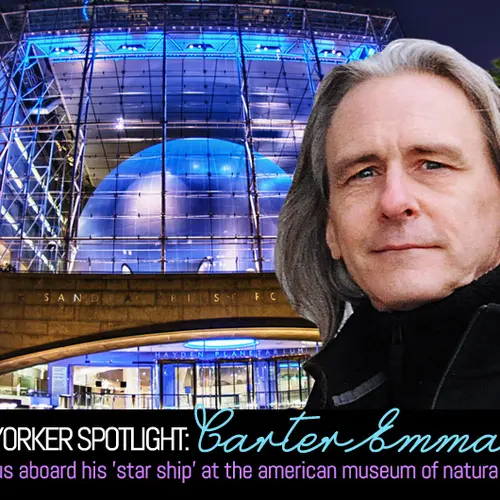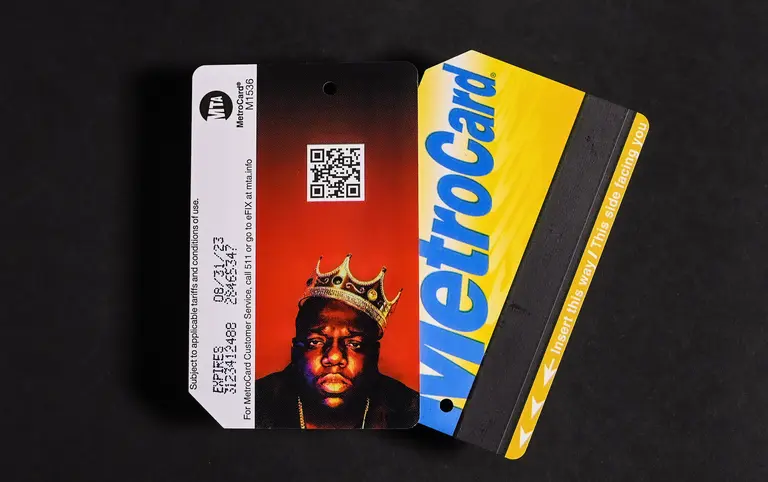New Yorker Spotlight: Carter Emmart Brings Us Aboard His ‘Starship’ at the Museum of Natural History

The Rose Center for Earth and Space via “From the Past” via photopin (license); Carter Emmart ©AMNH/R. Mickens
Here in New York, we think of space is terms of square feet and how little of it we have. But for Carter Emmart, space has an entirely different meaning. In his case, it refers to a space that is harder to quantify and infinitely large.
Carter is the Director of Astrovisualization at the American Museum of Natural History, where he focuses on creating a means to visualize the universe based on what we currently know about it. He is responsible for giving us access to stars, planets, and galaxies through the museum’s space shows in the beautiful Hayden Planetarium–like the currently running Dark Universe, overseeing the development of an interactive 3D atlas known as the Digital Universe, and running educational programs including the Digital Flight School.
We recently spoke with Carter to learn more about his role digitizing the universe and why the American Museum of Natural History can be thought of as a virtual space ship.
 Inside the Rose Center for Earth and Space via Space-age architecture via photopin (license)
Inside the Rose Center for Earth and Space via Space-age architecture via photopin (license)
Growing up, were you fascinated by space?
I’m as old as the space program, if you want to measure that by the year the first human, Yuri Gagarin, went into space. Arguably, the space program started in 1957 with Sputnik. My generation couldn’t help but be excited by the fact that we were going into space. I was eight when we landed on the moon, and I remember it like it was yesterday. It was a tremendous marker in so many people’s lives in the sense that you knew where you were when that happened. I would say that my interest in astronomy goes back to trying to understand and formalize a picture in my head of the layout of the universe. I found that exciting and fascinating and now my job here is to communicate that to the public at large.
Do you remember visiting the museum as a kid?
I was captivated certainly by the space program, but also by the American Museum of Natural History. We were family members and by the time I was ten, I was taking classes at the Hayden Planetarium, which I took all the way up through high school. On breaks from school, I would come in and utilize the library of the planetarium. I have a picture of myself that my dad took of me making clay dinosaurs when I was eight. I keep it around because it reminds me of why I work here. It’s really about inspiring young minds of all ages. The more that we can do to help people realize and understand our interconnectedness to the natural world is a vital thing.

A show on the dome via AMNH
Can you share a bit about what your role at the museum involves?
With my title, Director of Astrovisualization, sometimes I have to laugh because people think I read astrological charts or cast fortunes for people. It’s a quicker way of saying Director of Astronomical and Astrophysical Data Visualization, which is essentially what it’s about. Astronomical means charting the universe as we see it so astronomers take data as to what they see, and astrophysics is applying the principals of physics to envision a process to create the things that we see. Now we use advanced computing to do that. Our shows are a direct result of what we chart and what we understand through astrophysics. My role is to oversee that data visualization. So, one of my hats is to direct the space show and the other is to basically direct intern programs.
I’ve had tremendous help with students to visualize and extend our digital universe. I have graduate students from Linköping University, a Swedish university that I have been working with since 2002. That’s enabled us to create an interactive way of seeing the digital universe that we show about once a month in our Astronomy Live public programs. But I also oversee high school students beginning to work on reducing data from Mars. We’re utilizing NASA software that allows us to take the pictures sent back from the rovers and turn those into accurate 3D models. The goal of that in a museum context is to create this complete digital collection that goes into software that we can visualize on the dome. We work very hard on our productions like Dark Universe, but in addition to that we can also go live with the 3D atlas, the Digital Universe, and move through it interactively.

From Known Universe
When you mention visualizing data, how do you design it in a way that is accessible?
I like to say context through continuity. What I mean by that is we kind of see where we are in the universe. And so to understand why some rock on Mars that is a little bit bigger than a penny was a specific target by scientists you might say, “Wow, this is very detailed. Where is that little rock in regards to where the rovers were driving?” In order see where the rovers were going, you need to have a more general overview. You need a view from the satellite above so that you can see a map of where these rovers were going. From that map, you can see how that relates to the globe of Mars so that you are seeing the latter context. Then you say, “Well, that’s Mars. Where is Mars in the solar system with respect to where we are on the Earth?”
We did a video a few years ago called the Known Universe in collaboration with a show on comparative cosmologies at the Rubin Museum of Art, and it went viral. Their goal was to bring our digital universe visualization into this exhibit as a kind of a culmination of where we are in modern cosmology and understanding of the universe. In the Rubin’s case, they had the Buddhist, Hindu, and Jain mandalas being compared and then coming up to date with Copernicus and Newton and so on, and then coming up to this atlas of the universe. The Known Universe starts in the Himalayas, which is the setting you are envisioning by being at the Rubin Museum [The Rubin is focused on the ideas, cultures, and art of Himalayan Asia], and moves seamlesly out so we see the Earth, the satellites that surround us, our orbit around the sun, our local solar neighborhood, and then how the galaxy is just part of a neighborhood of galaxies in a much broader universe. I think the reason this went viral is because it shows a continuum of motion–an unbroken chain where we sit in this layout of the universe and then come back. I think various applications of that general principal are how we string together the abstractions of the universe back to where we are in space. We are, in fact, on a space ship moving through space.
You were one of the original team members at the museum who was part of a NASA-funded Digital Galaxy Project that helped redefine how a planetarium theater can present science to the public. What does this entail?
That redefinition had to do with where we were when the Rose Center for Earth and Space opened in 2000. The idea of having a data visualization of the universe as a movie was completely new. I’m talking about bringing together this technology of full-dome video with the means to accurately portray where stars are within the galaxy, where the galaxies are, and where our solar system sits within all of that. The redefinition had to do with the sky where we would show the stars. The original Hayden Planetarium that opened in 1935 showed the sky as we see it and very accurately could portray the night sky and where the planets are. Whereas with a video system fed by computers, we can move virtually around a field of data, an immersion in a true model of the universe, a real atlas of the universe.

The Rose Center for Earth and Space during a 2011 installation via “From the Past” via photopin (license)
What is one thing most New Yorkers do not know about space?
What I like to think is that the planetarium on 81st street is the closest thing to a virtual starship that has ever been created because we cannot go faster than the speed of light. We haven’t figured that out. Maybe tomorrow someone will figure that out and then we would have Star Trek. But for now, our ability to move ourselves light years away and look back from many of the local stars, you would be seeing exactly what the view is from that star. Likewise if we move out to the Andromeda Galaxy we would see us far away. What we are showing is accurate and our motion through it since we know where things are and we’ve developed the techniques for getting distances and so forth, we know the true layout. We are not bounded by the speed of light. I kind of joke that I don’t have a car anymore in New York because I have a starship.
What does making space accessible to museum visitors mean to you?
Personally, I’ve always been interested in this and it’s an honor and a privilege to bring this to people and share it. I enjoy the interaction that really shows we are in this 3D atlas. This is something when we show it interactively the audience begins to understand we could have gone right or left here, it’s not just the animation that gets played over and over.
It’s also the appreciation of what humanity has been able to put together. All we’re doing here is standing on top of this tremendous ability for humankind to understand where we are in the universe and that’s taken place over generations. This is really the scholarship of astronomers and astrophysicists across generations. Our ability to display that here at the museum and personally for me to be a medium helping to bring that across to people is very rewarding. I consider it my life’s work.
***
[This interview has been edited]
American Museum of Natural History
Central Park West at 79th Street
New York, NY 10024
RELATED:
Explore NYC Virtually
Leave a reply
Your email address will not be published.



































Final Frontier Design is a design firm crafting space suits in New York for the future of space travel. At FFD you can wear a real space suit, perform astronaut-oriented tasks, and pilot your own craft on the Moon while suited in flight simulator!
This is a wonderful piece on a fascinating man, thank you. I’ve been in that starship while Carter’s been flying, and it is truly an experience never to be forgotten.